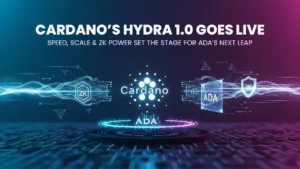Sui Tests Wearables, XDC Foresees $7T in Tokenization, and ARK Buys Tech Stocks

Sui is expanding into Asia with stablecoin payments and a wellness-linked device, turning blockchain into something visible at the checkout line and in consumer wearables. XDC Network has quantified its tokenization vision, suggesting $7 trillion in assets could migrate on-chain if even a fraction of global finance embraces digital rails. Meanwhile, ARK Invest re-entered surging tech stocks with a $28.6 million buy, a signal that risk budgets in traditional markets are reopening.
- Why is Asia a Crucial Testbed?
- Sui: Stablecoin Payments and a Wellness Pilot
- Investor implications:
- XDC: Tokenization Measured In Trillions
- Institutional checklists:
- What to watch next:
- ARK: Risk Appetite Shifts Back Toward Growth
- Market Impact Scenarios
- Bull Case:
- Base Case:
- Bear Case:
- Key Data Points
- Conclusion
- Frequently Asked Questions About Sui, XDC, ARK Crypto Adoption
- What did Sui announce?
- Why does DPoS matter in these stories?
- What is XDC’s projection?
- How should ARK’s move be interpreted?
- Glossary of Key Terms
These stories matter because they address three levers of adoption: consumers, institutions, and capital allocators. Each headline offers milestones that can be tracked in the coming months: transaction counts in restaurants, issuers of tokenized assets, and the durability of risk-on sentiment in equities.
What connects these stories is Delegated Proof of Stake (DPoS). The model is seldom mentioned outright, but its mix of quick finality and steady costs is what makes large-scale payments and tokenization workable.
ALSO READ: TRON Sets New Records in USDT Transfers as Sui Activates Google Payment Agents
Why is Asia a Crucial Testbed?
Asia has long been fertile ground for digital adoption. South Korea is among the most connected economies in the world, with smartphone penetration above 90% and a retail payments market that leans heavily on QR codes and digital wallets.
Introducing a KRW-backed stablecoin on a chain is not an experiment in infrastructure; it is a direct challenge to card networks in a country where consumers already pay digitally.
Wellness wearables also have a strong foothold. The global smart wearable market is projected to surpass $150 billion by 2028, and Asia is one of its fastest-growing regions.
Linking a blockchain layer to that trend adds not just payments but incentives tied to health outcomes. That creates both opportunity and risk: adoption could drive sticky engagement, but poor execution could be dismissed as gimmickry.
For institutional finance, Asia is equally central. Singapore, Hong Kong, and South Korea are hubs for regulated digital asset experimentation. With tokenization pilots already underway in bonds and funds, the region is a live laboratory.
Against that backdrop, Sui’s partnerships and XDC’s forecast do not look like isolated experiments. They are part of a broader pattern where Asia tests what might later scale globally.
Sui: Stablecoin Payments and a Wellness Pilot
Sui’s partnership with T’order, South Korea’s leading table-ordering platform, positions blockchain at the dining table. A KRW stablecoin payment rail will allow customers to settle bills instantly, while merchants can manage loyalty programs on the chain.
T’order’s footprint is significant: millions of users, hundreds of thousands of devices, and billions in annual transaction volume. Even a limited rollout could validate whether blockchain can displace or at least complement card networks.
At the same time, CUDIS is launching a wellness smart ring integrated with Sui. The device, capped at 1,500 units for its initial drop, ties rewards to healthy behavior such as activity and sleep.
ALSO READ: ARK Invest Returns to Alibaba After a 4-Year Hiatus as Europe AUM Crosses 1B Mark
Data-sensitive applications like this require privacy tools, which Sui provides through components like Walrus and Seal. The key is not putting raw health data on-chain, but routing the elements that need verification or settlement.
Tweets confirm both initiatives:
Investor implications:
- Payment economics: Card rails take a cut on every transaction. If KRW stablecoin payments prove cheaper and faster, merchants have a clear incentive.
- Merchant adoption curve: The first data point will be device activations. If even 10–20% of T’order’s footprint enables stablecoin payments in year one, that is a meaningful wedge into mainstream commerce.
- Consumer trust: Koreans are familiar with digital payments, but stablecoins need credibility. Integration must feel seamless to gain adoption.
- Hardware stickiness: The CUDIS ring pilot is small but measurable. Pre-orders, daily active users, and retention rates will determine whether health-linked incentives hold.
This is where DPoS quietly matters. Dining transactions and device-linked rewards cannot tolerate network delays or fee spikes. Elected validators with stake-based incentives provide steady throughput and low-cost settlement, making blockchain fade into the background exactly where it should be for consumers.
XDC: Tokenization Measured In Trillions
While Sui targets consumer flows, XDC Network is speaking directly to institutions. Co-founder Ritesh Kakkad told CoinChapter that if just 1% of global financial assets roughly $700 trillion move on chain, the tokenization market could reach $7 trillion within five years.
Tokenization is not new. J.P. Morgan’s Onyx has already settled tokenized intraday repos, and Franklin Templeton has issued a tokenized money-market fund. What XDC adds is scale and a pitch that its infrastructure, built with compliance layers and Delegated Proof of Stake governance, can serve as settlement rails for trade finance and payments.
Institutional checklists:
- Settlement speed: Traditional cross-border settlement can take days. Tokenized rails can compress this to minutes.
- Auditability: Assets on chain can provide real-time reporting, reducing reconciliation costs.
- Compliance: Banks require KYC and AML controls. XDC emphasizes validators that meet these standards.
- Predictable fees: Institutions budget to the cent. Fee volatility undermines confidence.
Competitor context: Ethereum Layer 2s, Polygon, and Avalanche are also pitching tokenization, but XDC argues that its leaner DPoS design keeps costs low and performance steady. Whether that claim resonates will depend on adoption.
What to watch next:
- Named issuers of tokenized instruments.
- Regular monthly reports with audits.
- Counterparties that include banks or large asset managers.
Without those, the $7 trillion projection is just math. With them, it becomes a roadmap.
ARK: Risk Appetite Shifts Back Toward Growth
Crypto markets often shadow traditional risk cycles. When investors retreat from growth, digital assets lose attention. When they return, liquidity widens. ARK Invest’s $28.6 million purchase of surging tech stocks, including Chinese names like Alibaba, signals that risk budgets are opening again.
Alibaba had just rallied on AI updates and overseas data center announcements, making ARK’s timing notable. For crypto, the signal is indirect but important. Growth allocators widening their lens often revisit frontier themes, including blockchain networks pitching scalable infrastructure.
Investor implications:
- Sentiment shift: A modest risk-on tone improves the backdrop for projects like Sui and XDC.
- Capital flows: If ARK’s buys represent a trend, liquidity could rotate toward adjacent risk assets.
- Correlation: Crypto often trades as high-beta growth. Positive sentiment in equities can spill over.
This does not guarantee inflows, but it sets the tone. If ARK and other managers continue to add exposure, digital assets tied to real-world use cases are likely to benefit.
Market Impact Scenarios
Bull Case:
- Sui secures significant merchant adoption, with KRW stablecoin payments live at thousands of devices.
- CUDIS ring sees strong retention, proving blockchain can support wearables.
- XDC lands one or more major banks issuing tokenized assets with monthly audits.
- Risk-on tone holds as ARK and peers expand exposure, lifting liquidity across frontier assets.
Base Case:
- Sui payments roll out gradually, with limited but growing adoption.
- CUDIS ring remains a niche experiment.
- XDC pilots tokenization with smaller fintechs before banks engage.
- Risk-on sentiment stays muted but does not retreat, keeping adoption windows open.
Bear Case:
- Sui payments face regulatory or merchant hurdles, slowing rollout.
- CUDIS pilot underperforms, dismissed as a gimmick.
- XDC’s $7T projection remains theoretical without issuers.
- ARK’s move proves short-lived, with risk appetite fading, tightening capital across frontier markets.
ALSO READ: SunPerp Debuts on TRON, Challenges dYdX, GMX, and Hyperliquid with Cheaper Trades
Key Data Points
| Item | Figure | Why It Matters |
| T’order + Sui partnership | Billions in annual transactions | Tests blockchain payments at consumer scale. |
| Sui x CUDIS wellness ring | 1,500 units | Hardware pilot with measurable engagement. |
| XDC tokenization forecast | $7 trillion in 5 years | Benchmarks RWA adoption potential. |
| ARK tech buys | $28.6 million | Signals risk budgets reopening. |
Conclusion
Three stories frame the week’s direction. Sui is testing blockchain in daily life, from restaurants to wearables. XDC is putting a concrete number on tokenization’s upside, pushing attention toward issuers and audits. ARK’s renewed tech buys hint at a risk-on turn, creating a backdrop where adoption headlines are more likely to gain traction.
The common denominator is simple: adoption must be measured by data, counterparties, and usage, not narratives. Delegated Proof of Stake underpins these initiatives, delivering the cost efficiency and transaction speed that enhance their credibility. If the coming weeks see broader device activations, new tokenized issuers, and sustained investor risk appetite, the market may shift decisively from speculative momentum toward structured, large-scale adoption.
Frequently Asked Questions About Sui, XDC, ARK Crypto Adoption
What did Sui announce?
A payments partnership with T’order in South Korea and a wellness pilot with CUDIS, including a limited run of smart rings.
Why does DPoS matter in these stories?
Delegated Proof of Stake provides fast confirmations and predictable fees, critical for checkout payments, device-linked rewards, and institutional settlement.
What is XDC’s projection?
That tokenized assets could reach $7 trillion within five years if just 1% of global assets move on chain.
How should ARK’s move be interpreted?
As a signal of renewed risk appetite. Growth investors re-entering tech often broaden exposure, which historically correlates with stronger interest in digital assets.
Glossary of Key Terms
- Stablecoin: Digital token pegged to a fiat currency.
- Tokenization: Representation of real-world assets on blockchain.
- Validator: Node responsible for producing blocks and securing the network.
- Delegation: Assignment of stake to validators in DPoS systems.
- Finality: The Point at which a transaction becomes irreversible.
- Throughput: Transactions processed per second.
- Settlement: Legal and financial completion of a trade.
- RWA: Real-world assets moved to blockchain.
- KYC: Identity verification for compliance.
- DPoS: Delegated Proof of Stake, consensus using elected validators.




